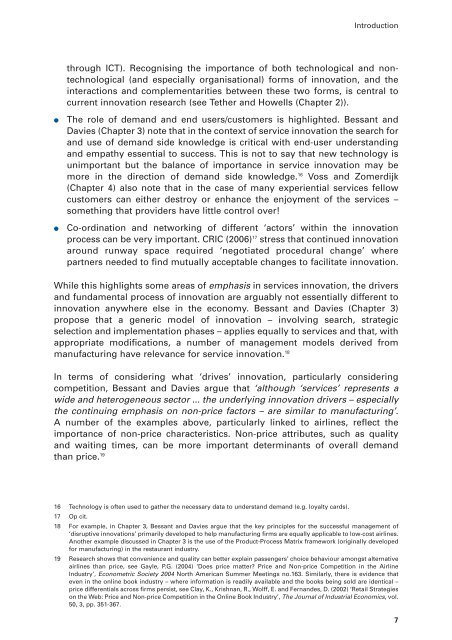Innovation in Services - Department for Business, Innovation and Skills
Innovation in Services - Department for Business, Innovation and Skills
Innovation in Services - Department for Business, Innovation and Skills
You also want an ePaper? Increase the reach of your titles
YUMPU automatically turns print PDFs into web optimized ePapers that Google loves.
Introduction<br />
through ICT). Recognis<strong>in</strong>g the importance of both technological <strong>and</strong> nontechnological<br />
(<strong>and</strong> especially organisational) <strong>for</strong>ms of <strong>in</strong>novation, <strong>and</strong> the<br />
<strong>in</strong>teractions <strong>and</strong> complementarities between these two <strong>for</strong>ms, is central to<br />
current <strong>in</strong>novation research (see Tether <strong>and</strong> Howells (Chapter 2)).<br />
● The role of dem<strong>and</strong> <strong>and</strong> end users/customers is highlighted. Bessant <strong>and</strong><br />
Davies (Chapter 3) note that <strong>in</strong> the context of service <strong>in</strong>novation the search <strong>for</strong><br />
<strong>and</strong> use of dem<strong>and</strong> side knowledge is critical with end-user underst<strong>and</strong><strong>in</strong>g<br />
<strong>and</strong> empathy essential to success. This is not to say that new technology is<br />
unimportant but the balance of importance <strong>in</strong> service <strong>in</strong>novation may be<br />
more <strong>in</strong> the direction of dem<strong>and</strong> side knowledge. 16 Voss <strong>and</strong> Zomerdijk<br />
(Chapter 4) also note that <strong>in</strong> the case of many experiential services fellow<br />
customers can either destroy or enhance the enjoyment of the services –<br />
someth<strong>in</strong>g that providers have little control over!<br />
● Co-ord<strong>in</strong>ation <strong>and</strong> network<strong>in</strong>g of different ‘actors’ with<strong>in</strong> the <strong>in</strong>novation<br />
process can be very important. CRIC (2006) 17 stress that cont<strong>in</strong>ued <strong>in</strong>novation<br />
around runway space required ‘negotiated procedural change’ where<br />
partners needed to f<strong>in</strong>d mutually acceptable changes to facilitate <strong>in</strong>novation.<br />
While this highlights some areas of emphasis <strong>in</strong> services <strong>in</strong>novation, the drivers<br />
<strong>and</strong> fundamental process of <strong>in</strong>novation are arguably not essentially different to<br />
<strong>in</strong>novation anywhere else <strong>in</strong> the economy. Bessant <strong>and</strong> Davies (Chapter 3)<br />
propose that a generic model of <strong>in</strong>novation – <strong>in</strong>volv<strong>in</strong>g search, strategic<br />
selection <strong>and</strong> implementation phases – applies equally to services <strong>and</strong> that, with<br />
appropriate modifications, a number of management models derived from<br />
manufactur<strong>in</strong>g have relevance <strong>for</strong> service <strong>in</strong>novation. 18<br />
In terms of consider<strong>in</strong>g what ‘drives’ <strong>in</strong>novation, particularly consider<strong>in</strong>g<br />
competition, Bessant <strong>and</strong> Davies argue that ‘although ‘services’ represents a<br />
wide <strong>and</strong> heterogeneous sector ... the underly<strong>in</strong>g <strong>in</strong>novation drivers – especially<br />
the cont<strong>in</strong>u<strong>in</strong>g emphasis on non-price factors – are similar to manufactur<strong>in</strong>g’.<br />
A number of the examples above, particularly l<strong>in</strong>ked to airl<strong>in</strong>es, reflect the<br />
importance of non-price characteristics. Non-price attributes, such as quality<br />
<strong>and</strong> wait<strong>in</strong>g times, can be more important determ<strong>in</strong>ants of overall dem<strong>and</strong><br />
than price. 19<br />
16 Technology is often used to gather the necessary data to underst<strong>and</strong> dem<strong>and</strong> (e.g. loyalty cards).<br />
17 Op cit.<br />
18 For example, <strong>in</strong> Chapter 3, Bessant <strong>and</strong> Davies argue that the key pr<strong>in</strong>ciples <strong>for</strong> the successful management of<br />
‘disruptive <strong>in</strong>novations’ primarily developed to help manufactur<strong>in</strong>g firms are equally applicable to low-cost airl<strong>in</strong>es.<br />
Another example discussed <strong>in</strong> Chapter 3 is the use of the Product-Process Matrix framework (orig<strong>in</strong>ally developed<br />
<strong>for</strong> manufactur<strong>in</strong>g) <strong>in</strong> the restaurant <strong>in</strong>dustry.<br />
19 Research shows that convenience <strong>and</strong> quality can better expla<strong>in</strong> passengers’ choice behaviour amongst alternative<br />
airl<strong>in</strong>es than price, see Gayle, P.G. (2004) ‘Does price matter? Price <strong>and</strong> Non-price Competition <strong>in</strong> the Airl<strong>in</strong>e<br />
Industry’, Econometric Society 2004 North American Summer Meet<strong>in</strong>gs no.163. Similarly, there is evidence that<br />
even <strong>in</strong> the onl<strong>in</strong>e book <strong>in</strong>dustry – where <strong>in</strong><strong>for</strong>mation is readily available <strong>and</strong> the books be<strong>in</strong>g sold are identical –<br />
price differentials across firms persist, see Clay, K., Krishnan, R., Wolff, E. <strong>and</strong> Fern<strong>and</strong>es, D. (2002) ‘Retail Strategies<br />
on the Web: Price <strong>and</strong> Non-price Competition <strong>in</strong> the Onl<strong>in</strong>e Book Industry’, The Journal of Industrial Economics, vol.<br />
50, 3, pp. 351-367.<br />
7
















